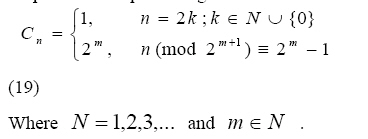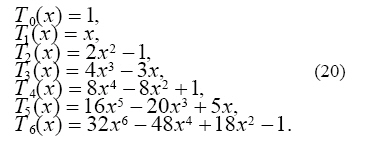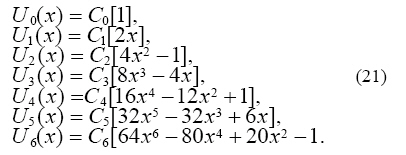
|
Journal of Applied Sciences and Environmental Management
World Bank assisted National Agricultural Research Project (NARP) - University of Port Harcourt
ISSN: 1119-8362
Vol. 11, Num. 4, 2007, pp. 147-149
|
Journal of Applied Sciences and Environmental Management, Vol. 11, No.
4, 2007, pp. 147-149
Exact Solutions for Chebyshev Equations by using the Asymptotic
Iteration
Method
SOUS A. J. *, M. AL-HAWARI1
Department of Mathematics, Al-Quds Open University, Nablus Email: melhem_fan@hotmail.com
1Department of Mathematics, Al-jouf University, Askaka, Saudi Arabia
* Corresponding author: Sous A. J
Code Number: ja07112.
ABSTRACT:
The asymptotic iteration method is used in order to solve the Chebyshev
differential equations, and to reproduce the Chebyshev polynomials of the first
and second kinds respectively. It is shown that the asymptotic iteration method
is valid for any degree .
The Chebyshev polynomials are important in many areas of mathematics, and
physics. Particularly in the approximation theory since the roots of the Chebyshev
polynomials of the first kind are used in the polynomial interpolation [1].
In the study of differential equations, Chebyshev polynomials arise as the
solution to the Chebyshev differential equations
(1-x2) yn''(x) -x yn'(x) +n2 yn(x) =0, (1)
and
[[(1-x2) yn''(x)-3x yn'(x)+n(n+2) yn(x)=0,]] (2)
where n = 0 , 1, 2 , 3 , ... for the polynomials Tn (x), Un (x)
of the first and second kinds respectively [2,8]. These
equations are special case of the Sturm-Liouville equation [3].
Chebyshev polynomials are used virtually in the field of numerical analysis,
and it holds particular importance in different subjects including orthogonal
polynomials, and polynomial approximation. Ell-gendi [4] has extensively shown
how Chebyshev polynomials can be used to solve linear integral equations, integro-differential
equations, and ordinary differential equations. Various methods for solving
linear and nonlinear ordinary differential equations [5, 6, 7] were devised
at about
the same time and were based on the discrete orthogonality relationships of
the Chebyshev polynomials.
In the literature [2, 8], the Chebyshev differential equations has been solved
very heavily using the power series solution method. The reader may face several
problems in following the power series solution technique, in which guessing
the solution in many cases is very difficult task. Therefore, we applied a
new method, the asymptotic iteration method (AIM) [9] to solve this kind of
differential
equations, where we don’t need to use the recurrence relation to find the
general solution. This method is very easy to implement in the case of Chebyshev
differential equations. The results of this method are very accurate. Moreover,
the reader can obtain the solutions without a strong background in mathematics.
The paper is organized as follows: in section 2 we will describe the AIM to solve
the Chebyshev differential equations. In section 3 our analytical results for
the Chebyshev polynomials, and then we conclude and remark therein.
2. Formalism of the asymptotic iteration
method for the Chebyshev differential
equations
The starting point to apply the AIM is to rewrite equations (1) and (2) in
the following form:
yn '' (x)= k0 (x) yn (x) + z0 (x)
yn (x) (3)
Where k0 (x) and z0 (x) are defined for equations (1),
and (2) as:

Note that for equation  equation
(2)a = b = 1. equation
(2)a = b = 1.
In order to find a general solution to equation (3) we rely on the symmetric
structure of the right -hand side of equation (3). Thus if we differentiate
equation (3) with respect to , we obtain [9-12]
y"n ( x)= k1 (x) yn (x) + z1 (x)
yn (x) (5)
where

Likewise, the calculations of the second derivative of equation (3) yield

where

Thus for (j+1) and (j+2)th
derivatives, j = 1, 2, 3, ..we have

and

respectively, where

The ratio of the ( j + 1 ) and ( j + 2 ) th derivatives
can be expressed as

For sufficiently large j , we can introduce the”asymptotic” aspect of the method, that is

Thus equation (12) can be reduced to

which yields

Where Cn1 is the integration constant, and the
right-hand of equation (15) follows from equation
(11), and the definition of φ (x) . Substituting
equation (15) into equation (9) we obtain a
first-order differential equation

This, in turn, yields the general solution to the
equation (3)

Maple software producing a constant of the form

The results of our calculations with different values
of n are given, so that the reader may, if so
inclined reproduce our results.
Case (1): The first few Chebyshev polynomials of the first kind are

Case (2): The first few Chebyshev polynomials of the second kind are

In all cases, we have only considered the sixth order of polynomials of the
first and second kinds. This was so to make a clear comparison between the
results of this method and the results of [2, 8]. The obtained polynomials
are all in excellent agreement with the exact ones.
REFERENCES
- Johan P. Boud, November 2003. Chebyshev polynomial expansions for simultaneous
approximation of two branches of a function with application to the
one dimensional Bratu equation. Applied Mathematics and
Computation, Volume 143, Issuses 2-3, 189-200.
- Wikipedia, November 2002. Chebyshev polynomials. The free encyclopedia,
Versio 1.2.
- Heli Chen, and Bernie D. Shizgal, 2001. A spectral solution of the SturmLiouville
equation, Journal of Computational and Applied Mathematics, 136 17-35.
- El-gendi S E, 1969. Comput. J (U K)12 282.
- Streltsov I. P, 2000. J. Computer Physics Communications. 126 178-181.
- Ayegul Akyu-Daciolu, 2004. J. Applied Mathematics and Computation. 151
221-232.
- V. J Ervin, and E. P. Stephan 1992. Journal of Computational and Applied
Mathematics. 43 221-229.
- Handbook of Differential Equations, 1997, 3rd ed. Boston, MA: Academic
Press.
- H. Ciftci, Hall R L, and, Saad N, 2003. J. phys. A : Math. Gen. 36 11807.
- A. J. Sous, J. Mod. Phys. Lett. A, 21, 1675 (2006).
- A. J. Sous, Chin. J. Phys. 44, 167 (2006).
- A. J. Sous, J. Mod. Phys. Lett. A, 22, 1677 (2007).
Copyright 2007 - Journal of Applied Sciences & Environmental Management
|
